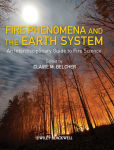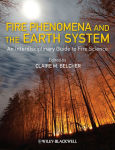Fire Phenomena and the Earth System brings together the various subdisciplines within fire science to provide a synthesis of our understanding of the role of wildfire in the Earth system. The book shows how knowledge of fire phenomena and the nature of combustion of natural fuels can be used to understand modern wildfires, interpret fire events in the geological record and to understand the role of fire in a variety of Earth system processes. By bringing together chapters written by leading international researchers from a range of geological, environmental, chemical and engineering disciplines, the book will stimulate the exchange of ideas and knowledge across these subject areas. Fire Phenomena and the Earth System provides a truly interdisciplinary guide that can inform us about Earth’s past, present and beyond.
Readership: Advanced students and researchers across a wide range of earth, environmental and life sciences, including biogeochemistry, paleoclimatology, atmospheric science, palaeontology and paleoecology, combustion science, ecology and forestry.
Fire Phenomena and the Earth System brings together the various subdisciplines within fire science to provide a synthesis of our understanding of the role of wildfire in the Earth system. The book shows how knowledge of fire phenomena and the nature of combustion of natural fuels can be used to understand modern wildfires, interpret fire events in the geological record and to understand the role of fire in a variety of Earth system processes. By bringing together chapters written by leading international researchers from a range of geological, environmental, chemical and engineering disciplines, the book will stimulate the exchange of ideas and knowledge across these subject areas. Fire Phenomena and the Earth System provides a truly interdisciplinary guide that can inform us about Earth’s past, present and beyond.
Readership: Advanced students and researchers across a wide range of earth, environmental and life sciences, including biogeochemistry, paleoclimatology, atmospheric science, palaeontology and paleoecology, combustion science, ecology and forestry.

Fire Phenomena and the Earth System: An Interdisciplinary Guide to Fire Science
352
Fire Phenomena and the Earth System: An Interdisciplinary Guide to Fire Science
352



